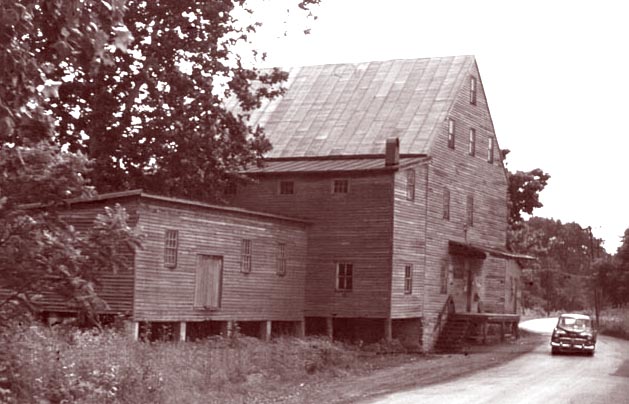Mill at Lantz Mills, VAN 38° 50' 26.3" W 078° 35' 43.3"
Twelve years after my grandfather's death, the by then widowed W. I. Wilkins married my grandmother thereby becoming my father's step-father and when I was born, my step-grandfather. Because of that, I and my sisters got to play in the mill when we were young. Given admonitions to "be careful" we generally had the freedom to go and do as we pleased. We, and some of the neighborhood kids, would give each other rides on the hand trucks as fast as we could push them, climb high on the sacks of feed, weigh ourselves on the feed scales and play in the bins of grain located on the top (third) floor from whence it was gravity-delivered, as needed, to the machinery on the first floor. They made dandy "sand boxes" in which to play. That mill was a great place for hide-'n'-seek. Of course, we always came home covered in dust. The mill foundation, mill race, and mill-dam (located on an adjacent property) were constructed some time prior to 1813, probably by Peter Holler, one of the original settlers of what would become the village of Lantz Mills. The extant mill building dates primarily to circa 1867, when it was reconstructed after being burned by Sheridan during the late unpleasantness. Electricity did not come to Lantz Mills until the Spring of 1928 when grandmother wrote on March 28, "They are bringing electric lights up the creek. I have not heard who all are taking lights." Originally a water power -- before being converted in the 1930s to electric motor -- the original power transfer system remained in use for the life of the mill. Instead of motors on each piece of equipment, a giant motor simply replaced the water wheel as source of power and its energy was conveyed throughout the structure by the mill's pre-electrification shafts, metal pulleys and leather belts. Power was turned on and off by forcing the belts on or off the rotating pulleys. Although vertical belts ran between the basement and three floors, most of the danger lay in the distribution system in the basement and I never went down there except with granddaddy (W. I. Wilkins). By the time I was born it had ceased to be a flour mill as commercial flour was readily available in the stores and no longer was being manufactured locally in each community. They no longer milled flour, though the equipment was still there, but dealt exclusively in grain and feed and medicines for animals. The photo of the mill with the bunch of men outside was taken the day of the auction when it was sold by W. I. Wilkins to the Sine brothers who operated it for a number of years thereafter. I believe it was they who closed it. It has not been used for years now and, while still (2007) standing, is in horrible shape and is much too dangerous to go inside for fear of some or all of it collapsing. This mill has been purchased by Mr. Christopher Hernandez-Roy who has been making repairs in an effort to stop the deterioration and restore the structure to its appearance in a bygone era. Chris has applied for and received status as a national historic place. |
